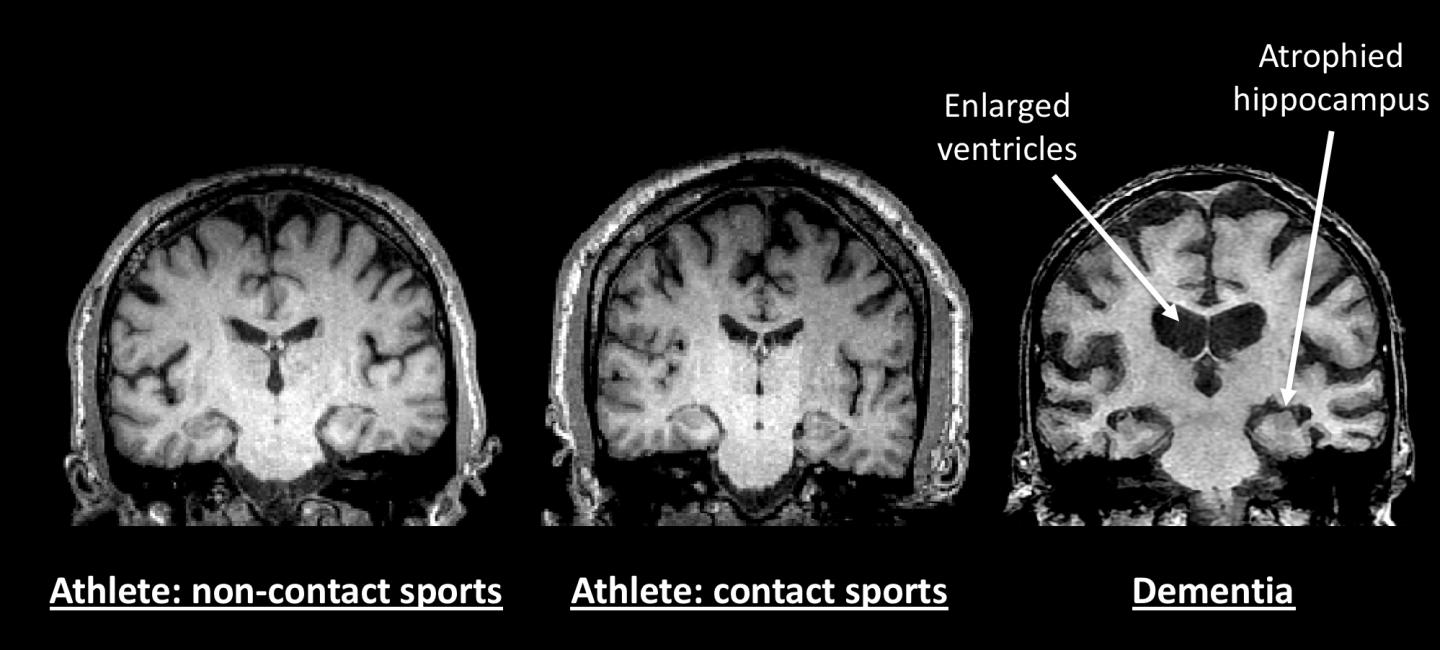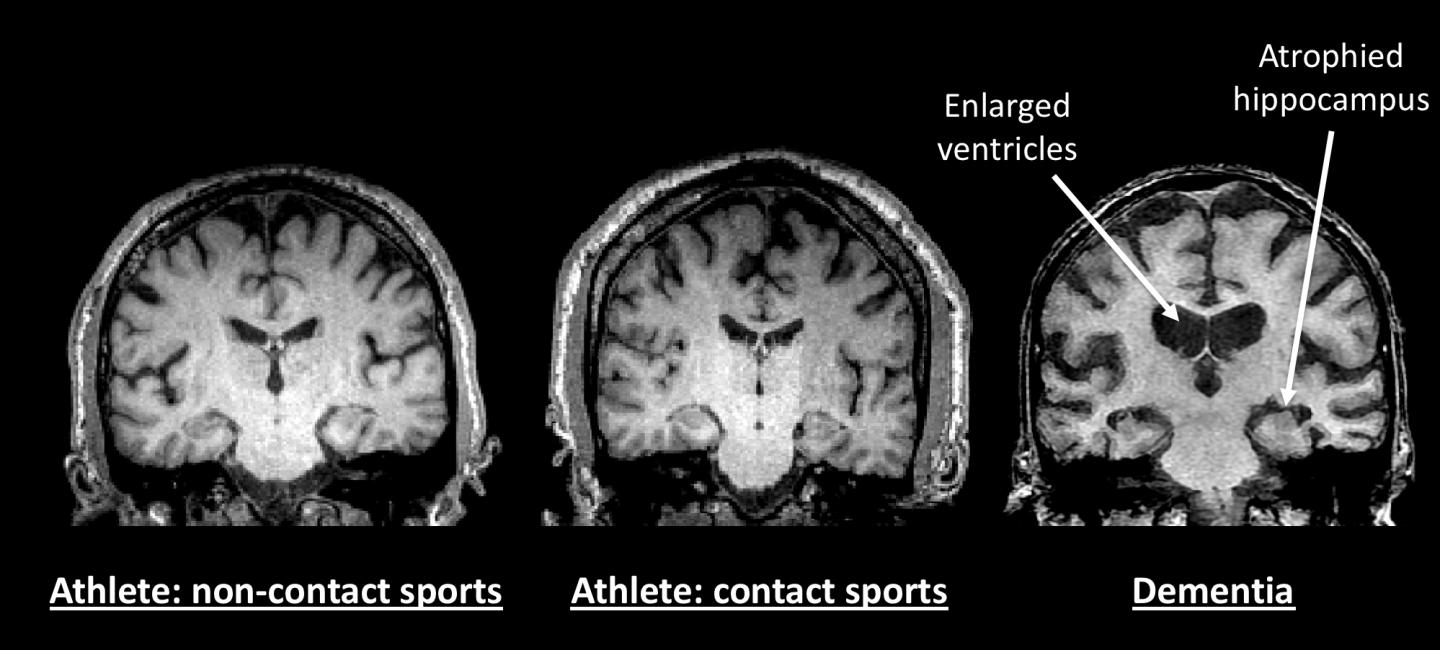
Credit: (Source: UB's Buffalo Neuroimaging Analysis Center)
BUFFALO, N.Y. –New University at Buffalo research is adding important information to the body of knowledge about the cognitive and behavioral status of a group of retired professional athletes who spent their careers in contact sports.
The study findings, from UB's Healthy Aging Mind Project, were published today online before print in the Journal of Head Trauma Rehabilitation. The study assessed 21 professional athletes retired from the National Football League and the National Hockey League on neuropsychological measures associated with mild cognitive impairment and executive function.
Four papers were published: an overview paper plus three additional papers assessing cognitive changes, executive function and advanced brain imaging. The study, which the researchers note, involved "a relatively small sample of former athletes," did not find evidence of early onset dementia in the retired players, which would be expected with chronic traumatic encephalopathy (CTE). The comprehensive, case-control study is believed to be the first age-matched athlete comparison designed to identify in retired living athletes cognitive symptoms or imaging findings that would indicate the presence of early onset dementia.
CTE in athletes has been linked to a history of concussive or sub-concussive hits. The researchers' overview paper notes: "…research to date on CTE based on pathological studies implies that most athletes who played contact sports professionally have a high probability of eventually experiencing CTE."
Most athletes with CTE damage do experience early onset dementia, although there is also some evidence that it may be possible to have CTE damage without clinical symptoms. The condition can only be diagnosed for certain after death.
'How prevalent is the problem?'
"We don't deny that CTE exists in some former athletes," said Barry S. Willer, PhD, professor of psychiatry in the Jacobs School of Medicine and Biomedical Sciences at UB, lead investigator and co-author on the papers. "It has been linked to contact sports and concussions that happen while playing those sports, but it's not a sure thing.
"The larger question is, how prevalent is the problem?"
The UB study was begun, in part, to address some limitations of previous studies on athletes and CTE. In pathological studies done at Boston University, CTE has been found in the brains of nearly all professional football and hockey players, many of whom had clearly exhibited dementia, and whose brains were donated for study by their families.
The assumption has been that CTE is a result of repetitive concussions and/or non-concussive hits sustained while playing sports. It has also been seen in the brains of much younger individuals. Investigators on these postmortem studies have cited selection bias and the lack of a control group, that is, donated brains from people who didn't play contact sports, as important limitations.
Assessing cognitive function
In 2013, with assistance from UB faculty and graduate students at the Jacobs School, the School of Nursing and the School of Public Health and Health Professions, Willer and his co-investigator, John Leddy, MD, director of the UB Concussion Management Clinic and professor of orthopaedics in the Jacobs School, developed a series of assessments that could provide a comprehensive view of the extent to which each athlete was functioning.
Willer said: "We designed the study so that when we discovered dementia we could also rule out or account for the myriad of other possible explanations for cognitive decline, such as mental health, lifestyle, eating habits, drug and alcohol abuse and so on."
The case-control study provides the first age-matched athlete comparison designed to identify in retired living athletes cognitive symptoms or imaging findings that would indicate early onset dementia.
The assessments of cognitive function (e.g., memory, attention, visual spatial orientation), executive function and mental health in the retired athletes didn't reveal statistically significant impairment compared to controls.
The researchers did find evidence of mild cognitive impairment (MCI) in more of the retired athletes than the controls, but said the rate was as expected for the age, education level and body mass index of the athletes, all factors that can raise the risk of MCI; it also was not statistically significant.
Advanced brain imaging detected no microscopic or macroscopic brain tissue injury differences in retired athletes versus the controls. The non-contact sport athletes were found to have a higher rate of microbleeds in the brain but these results only approached statistical significance.
Leddy added: "We looked at 21 former professional football and hockey players with an average age of 56. Not one qualified as having early onset dementia."
He noted that the athletes in the study had played an average of 8 years in their professional leagues, and thus likely had plenty of opportunities to experience concussions. Information from the athletes themselves about how many concussions they remember experiencing was deemed unreliable and was not included in the study.
Recruiting athletes
To do the study, Willer and Leddy approached the local alumni organizations of the Buffalo Bills and Buffalo Sabres. Representatives of both alumni groups served on the advisory committee of the project.
The UB researchers found that the athletes had valuable insights on how to frame the research. They also discovered that many athletes were interested in the research, exhibiting concerns that they, themselves, might be showing early signs of dementia.
Twenty-one controls who engaged in non-contract sports were recruited from local swimming, cycling and running clubs. These age-matched control athletes were still actively participating in their sport, were significantly better educated and healthier and, on average, weighed 50 pounds less than the retired professional athletes.
Both groups underwent comprehensive neuropsychological testing designed to identify MCI, considered an early sign of dementia. They filled out questionnaires about executive function and personality and underwent advanced brain imaging through magnetic resonance imaging (MRI). Family members were questioned about cognition and personality. Participants also provided information about diet, lifestyle, drug and alcohol use and cardiovascular risk factors. Blood samples were taken to assess cholesterol levels. Participants underwent thorough physical exams.
A key goal was to try to determine if symptoms signaling CTE, specifically, early-onset dementia, could be seen in retired professional athletes and how they compared with athletes who didn't play a contact sport. The researchers also wanted to assist former players and their families in addressing changes they were experiencing as a result of aging.
The main finding was that there was no significant difference in brain imaging, cognition, behavior or executive function between the retired professional athletes and the controls. The biggest health differences that were detected between the professional athletes included significant risk for obesity, chronic pain, orthopedic surgeries, and significant problems with sleep and anxiety.
"We went into this study with the expectation that we'd find any number of former athletes with dementia," said Leddy. "And while some of the former professional athletes reported concerns that they felt they were experiencing a decline in memory, and other cognitive issues, the study results did not bear this out.
Significant physical toll
"We did find the former athletes to be quite physically affected," Leddy said. "Some of them have had knees or hips replaced, many are in chronic pain, they have arthritis and some are not just overweight but obese." Sleep apnea also was reported by a number of the athletes.
Willer and Leddy agree that much more research needs to be done, especially on a larger number of living athletes who played a contact sport professionally. Willer and Leddy are internationally known for their decades-long research on concussions. They helped develop a new recovery method for people who have sustained a concussion that helps the individual gradually become more active after a brief period of rest. In 2017, Leddy contributed to the 2017 Concussion in Sport Group consensus document.
They are working on a $2 million National Institutes of Health grant to determine what concussions do to both one's body and brain, primarily looking at teenagers who have sustained a concussion during play. Leddy and Willer were previously funded by NFL Charities, the philanthropic foundation of the NFL, to determine an objective way to assess when athletes can safely return to play after a concussion.
###
Willer is the director of research for the UB Concussion Management Clinic. Leddy is the director of the UB Concussion Management Clinic and sees patients through
UBMD Orthopedics and Sports Medicine.
This research was funded primarily by the Ralph C. Wilson, Jr. Foundation. Wilson was the founder and owner of the Buffalo Bills until his death in 2014. The foundation did not have a role in selecting subjects, study design, data analysis or preparation of manuscripts to report findings. Its aim in funding the study was to increase the range of medical services available to retired athletes, including unbiased assessment of signs of early onset dementia.
The research was also supported by funding from the Robert Rich Family Foundation. Research reported in the publication on imaging was supported by the National Center for Advancing Translational Sciences of the National Institutes of Health under award Number UL1TR001412.
Media Contact
Ellen Goldbaum
[email protected]
716-645-4605
@UBNewsSource
http://www.buffalo.edu





